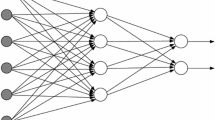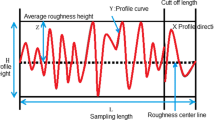Abstract
In this paper, the average surface roughness parameter (Ra) is predicted using artificial neural network (ANN) models and internal kernel information and external piezoelectric accelerometer data. Experiments were conducted to obtain data to develop ANN models to predict surface roughness. A total of 72 samples were used to develop two networks, one based on accelerometer inputs and the other on kernel inputs. The Matlab ANN Toolbox was used for the modeling. The two networks had similar characteristics. Feed-forward backpropagation, ‘newff’, was the network structure selected, with a Levenberg-Marquardt backpropagation training function, ‘trainlm’, and a backpropagation weight and bias learning function, ‘learngdm’. Samples obtained at the experimental stage were randomly divided into three groups to train (70% of the samples), validate (15% of the samples) and test (15% of the samples) the neural networks with a ‘dividerand’ data division function. The input processing functions used were ‘fixunknowns’, ‘removeconstantrows’ and ‘mapminmax’. The transfer function was ‘tansig’ for hidden layers and ‘purelin’ for the output layer. The output processing functions used were ‘removeconstantrows’ and ‘mapminmax’. The inputs consisted of the process parameters of radial depth of cut (Ae), the axial depth of cut (Ap), the spindle speed (N), the feed rate (f), the feed per tooth (fz), the cutting speed (Vc), the tooth passing frequency (ft), the cutting section (Cs), the material removal rate (MRR) and the cutting tool characteristics of the cutter radius (R), the number of teeth (Z) and the tool shape. The main difference between the two neural networks consisted of data origin: one considered data obtained with accelerometers and the other data collected in the NC kernel. Results showing high correlation factors between outputs and targets confirm that data provided by both internal and external sources can be useful for Ra prediction. However, NC kernel data provide several advantages.
Similar content being viewed by others
References
P. G. Benardos and G. C. Vosniakos, Predicting surface roughness in machining: a review, International Journal of Machine Tools and Manufacture, 43(8) (2003) 833–844.
M. Correa, C. Bielza and J. Pamies-Teixeira, Comparison of bayesian networks and artificial neural networks for quality detection in a machining process, Expert Systems with Applications, 36(3) (2009) 7270–7279.
M. E. Martellotti, An analysis of the milling process, Transactions of ASME, 63 (1941) 667.
G. Quintana, J. Ciurana and J. Ribatallada, Surface roughness generation and material removal rate in ball end milling operations, Materials and Manufacturing Processes, 25(6) (2010) 386–398.
H. K. Chang, J. H. Kim, I. H. Kim, D. Y. Jang and D. C. Han, In-process surface roughness prediction using displacement signals from spindle motion, International Journal of Machine Tools and Manufacture, 47(6) (2007) 1021–1026.
W. Grzesik, Influence of tool wear on surface roughness in hard turning using differently shaped ceramic tools, Wear, 265(3–4) (2008) 327–335.
C. Gologlu and N. Sakarya, The effects of cutter path strategies on surface roughness of pocket milling of 1.2738 steel based on Taguchi method, Journal Material Processing Technology, 206(1–3) (2008) 7–15.
W. H. Ho, J. T. Tsai, B. T. Lin and J. H. Chou, Adaptive network-based fuzzy inference system for prediction of surface roughness in end milling process using hybrid Taguchigenetic learning algorithm, Expert Systems with Applications, 36(2) (2009) 3216–3222.
Y. H. Tsai, J. C. Chen and S. J. Lou, An in-process surface recognition system based on neural networks in end milling cutting operations, International Journal of Machine Tools and Manufacture, 39(4) (1999) 583–605.
S. Y. Ho, K. C. Lee, S. S. Chen and S. J. Ho, Accurate modeling and prediction of surface roughness by computer vision in turning operations using an adaptive neuro-fuzzy inference system, International Journal of Machine Tools and Manufacture, 42(13) (2002) 1441–1446.
P. G. Benardos and G. C. Vosniakos, Prediction of surface roughness in CNC face milling using neural networks and Taguchi’s design of experiments, Robotics and Computer-Integrated Manufacturing, 18(5–6) (2002) 343–354.
M. Brezocnik and M. Kovacic, Integrated genetic programming and genetic algorithm approach to predict surface roughness, Materials and Manufacturing Processes, 18(3) (2003) 475–491.
M. Brezocnik, M. Kovacic and M. Ficko, Prediction of surface roughness with genetic programming, Journal of Materials Processing Technology, 157–158 (2004) 28–36.
A. M. Zain, H. Haron and S. Sharif, An overview of GA technique for surface roughness optimization in milling process, Proceedings of the International Symposium on Information Technology, ITSim 3 (2008) art. no 4631925.
A. M. Zain, H. Haron and S. Sharif, Application of GA to optimize cutting conditions for minimizing surface roughness in end milling machining process, Expert Systems and Application, 37(6) (2010) 4650–4659.
A. M. Zain, H. Haron and S. Sharif, Prediction of surface roughness in the end milling machining using Artificial Neural Network. Expert System Application, 37(2) (2010) 1755–1768.
J. R. Shie, Optimization of dry machining parameters for high-purity graphite in end-milling process by artificial neural networks: A case study. Materials and Manufacturing Processes, 21(8) (2006) 838–845.
P. V. S. Suresh, P. Venkateswara and S. G. Deshmukh, A genetic algorithmic approach for optimization of surface roughness prediction model, International Journal of machine Tools & Manufacture, 42 (2007) 675–680.
M. Correa, C. Bielza, M. J. D. Ramirez and J. R. Alique, A bayesian network model for surface roughness prediction in the machining process. International Journal of Systems Science, 39(12) (2008) 1181–1192.
C. Brecher, G. Quintana, T. Rudolf and J. Ciurana, Use of NC kernel data for surface roughness monitoring in milling operations, International Journal of Advanced Manufacturing Technologies, 53(9–12) (2011) 953–962.
B. Samanta and C. Nataraj, Surface roughness prediction in machining using computational intelligence, International Journal of Manufacturing Research, 3(4) (2008) 379–392.
B. Samanta, Surface roughness prediction in machining using soft computing, International Journal of Computer Integrated Manufacturing, 22(3) (2009) 257–266.
C. Brecher and T. Rudolf, Adaptive logging module for monitoring applications using control internal digital drive signals, Production Engineering, 3(3) (2009) 305–312.
T. Rudolf, C. Brecher and F. Possel-Dölken, Contact-based collision detection — A new approach to avoid hard collisions in machine tools, In: Donmez A, Deshayes L, editors, International Conference on Smart Machining Systems, 2007.
C. Brecher and T. Rudolf, Signalvorverarbeitung zur anwendung steuerungsintegrierter prozessüberwachung, wt Werkstattstechnik online, 99(7/8) (2009) 479–486.
J. Ciurana, G. Quintana and M. L. Garcia-Romeu, Estimating the cost of vertical high-speed machining centres, a comparison between multiple regression analysis and the neural networks approach, International Journal of Production Economics, 115(1) (2008) 171–178.
Author information
Authors and Affiliations
Corresponding author
Additional information
This paper was recommended for publication in revised form by Associate Editor Yong-Tae Kim
Guillem Quintana, Ph.D, is a project manager at Ascamm Technology Centre. He is also, a member of the Research group on Product, Process and Production (GREP) and associate professor in the Department of Mechanical Engineering and Industrial Construction in the University of Girona, UdG. He is Industrial Engineer (UdG) and Business Sciences graduate (UdG). His research is focused on manufacturing technologies, specially machining processes, with principal interest on instabilities and surface roughness evaluation.
Thomas Rudolf studied Mechatronics at the technical University of Darmstadt and received the degree of mechanical engineer in 2005. From 2005 to 2010 he worked as a research assistant at the Laboratory of Machine Tools, RWTH Aachen. His main research focus is the investigation monitoring strategies based on control internal data and drive signals.
Joaquim Ciurana is full Professor at the Department of Mechanical Engineering and Industrial Construction at the University of Girona. He is Head of the Product, Process and Production Engineering Group (GREP) at University of Girona. His research topic is Manufacturing Sciences. His current research focuses on developing models to characterize manufacturing processes. He mainly studies and analyses machining processes and additive manufacturing processes to make better plans for machining operations and better decisions based on process parameters selection and knowledge.
Christian Brecher is full Professor at RWTH Aachen, WZL. He carried out his degree at study of mechanical engineering (production engineering) at Aachen University and holds his Ph.D at the Laboratory for Machine Tools and Production Engineering (WZL) at Aachen University, chair of machine tools, department of machine technology. His current research focuses on developing machine tools and cutting processes. He mainly studies and analyses machine tools and monitoring systems applied to machine tools.
Rights and permissions
About this article
Cite this article
Quintana, G., Rudolf, T., Ciurana, J. et al. Surface roughness prediction through internal kernel information and external accelerometers using artificial neural networks. J Mech Sci Technol 25, 2877–2886 (2011). https://doi.org/10.1007/s12206-011-0806-0
Received:
Revised:
Accepted:
Published:
Issue Date:
DOI: https://doi.org/10.1007/s12206-011-0806-0




